全世界軍事百科事典
> アメリカ合衆国
> Shoulder Sleeve Insignia
> US Army Shoulder Patches
> Army Patches
> US-PTARM-00015

US Army Europe Patch, US Army
ランダム

4th Special Operation Command Support
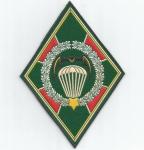
Rapid deployment Unit

Академия Вооруженных Сил Литвы Курс Офисера Штаба Сухопутных Воиск
情報を変える
Description
On a dark blue Norman shield with curved top 3 5/16 inches (8.41 cm) in height and 2 1/2 inches (6.35 cm) in width, palewise, a double handed flaming sword, 2 1/8 inches (5.40 cm) in length, hilt golden yellow, white blade, red flames, all below an arched chief 5/8 inch (1.59 cm) in depth on center line, 1/8 inch (.32 cm) from the top and sides of the shield in sky blue, the base of which is 5/8 inch (1.59 cm) on center line divided into a rainbow of five colors: red, golden orange, yellow, green, and blue in descending order.
Symbolism
The black shield, changed to dark blue when redesignated for the Headquarters U.S. Forces, European Theater in 1945, represented the darkness of oppression. The sword of liberation with rising flames represents justice by which the enemy power will be broken. Above the sword is a rainbow, emblematic of hope, containing the colors of the National Flags of the Allies. The sky blue above the rainbow represents a state of peace and tranquility to be restored to the enslaved people by the United Nations.
Background
The shoulder sleeve insignia was originally approved for the Supreme Headquarters, Allied Expeditionary Forces on 13 December 1944. It was redesignated for Headquarters, U.S. Forces, European Theater and revised to change the background color from black to dark blue on 2 August 1945. It was redesignated for the European Command on 23 June 1947. The insignia was redesignated for United States Army Europe on 7 November 1952. It was amended to include the specific shade of orange in the description on 22 July 1970. It was cancelled effective 16 July 2009. The insignia was reinstated for United States Army Europe on 7 July 2009, revoking the cancellation. The insignia was cancelled effective 17 April 2010. It was reinstated on 21 January 2011. (TIOH Dwg. No. A-1-367).
On a dark blue Norman shield with curved top 3 5/16 inches (8.41 cm) in height and 2 1/2 inches (6.35 cm) in width, palewise, a double handed flaming sword, 2 1/8 inches (5.40 cm) in length, hilt golden yellow, white blade, red flames, all below an arched chief 5/8 inch (1.59 cm) in depth on center line, 1/8 inch (.32 cm) from the top and sides of the shield in sky blue, the base of which is 5/8 inch (1.59 cm) on center line divided into a rainbow of five colors: red, golden orange, yellow, green, and blue in descending order.
Symbolism
The black shield, changed to dark blue when redesignated for the Headquarters U.S. Forces, European Theater in 1945, represented the darkness of oppression. The sword of liberation with rising flames represents justice by which the enemy power will be broken. Above the sword is a rainbow, emblematic of hope, containing the colors of the National Flags of the Allies. The sky blue above the rainbow represents a state of peace and tranquility to be restored to the enslaved people by the United Nations.
Background
The shoulder sleeve insignia was originally approved for the Supreme Headquarters, Allied Expeditionary Forces on 13 December 1944. It was redesignated for Headquarters, U.S. Forces, European Theater and revised to change the background color from black to dark blue on 2 August 1945. It was redesignated for the European Command on 23 June 1947. The insignia was redesignated for United States Army Europe on 7 November 1952. It was amended to include the specific shade of orange in the description on 22 July 1970. It was cancelled effective 16 July 2009. The insignia was reinstated for United States Army Europe on 7 July 2009, revoking the cancellation. The insignia was cancelled effective 17 April 2010. It was reinstated on 21 January 2011. (TIOH Dwg. No. A-1-367).
もう一度カテゴリーから: Army Patches
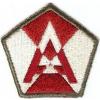 15 Army Patch. US Army
15 Army Patch. US Army
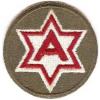 6 Army Patch. US Army
6 Army Patch. US Army
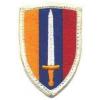 US Army Vietnam Patch. US Army
US Army Vietnam Patch. US Army
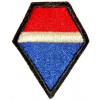 12 Army Group Patch. US Army
12 Army Group Patch. US Army
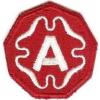 9 Army Patch. US Army
9 Army Patch. US Army



